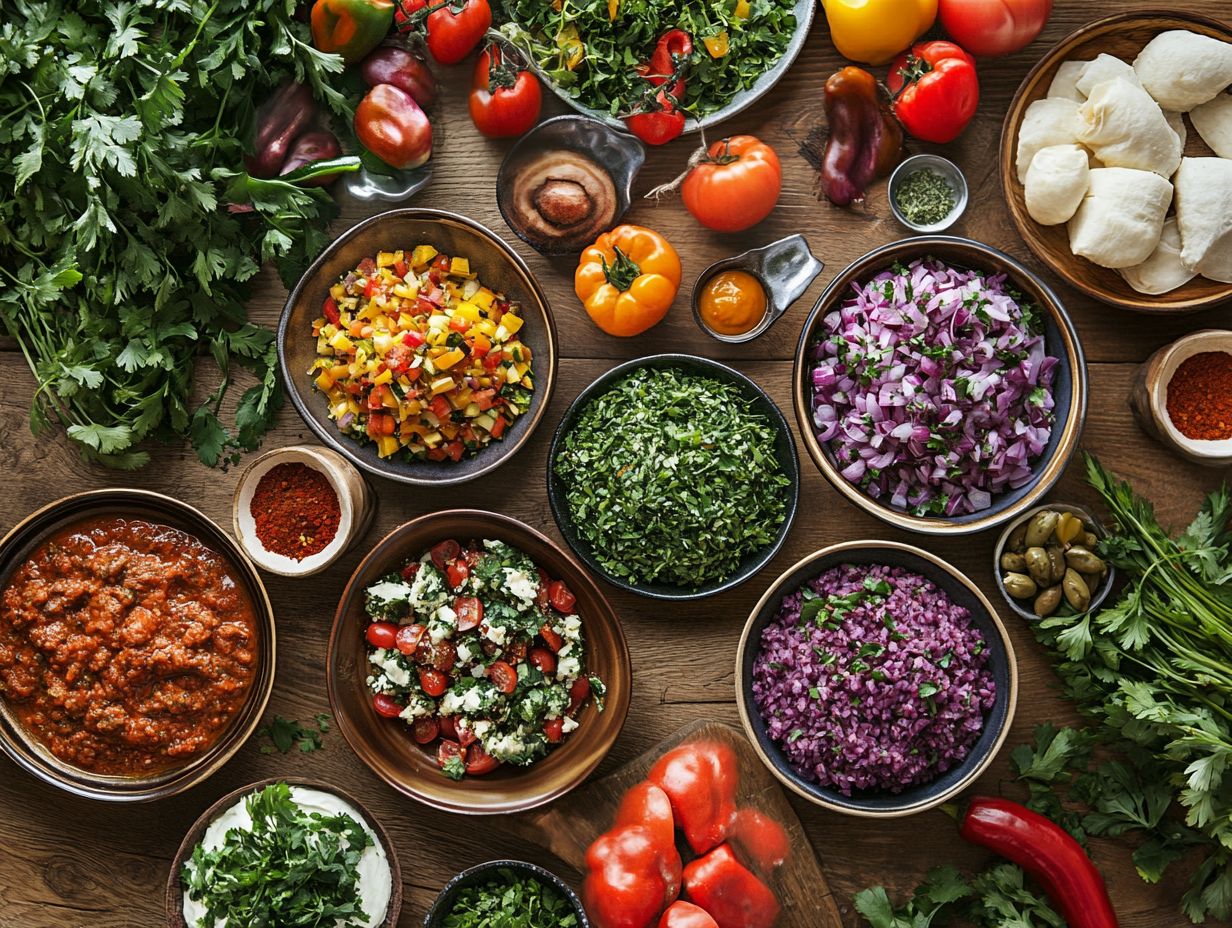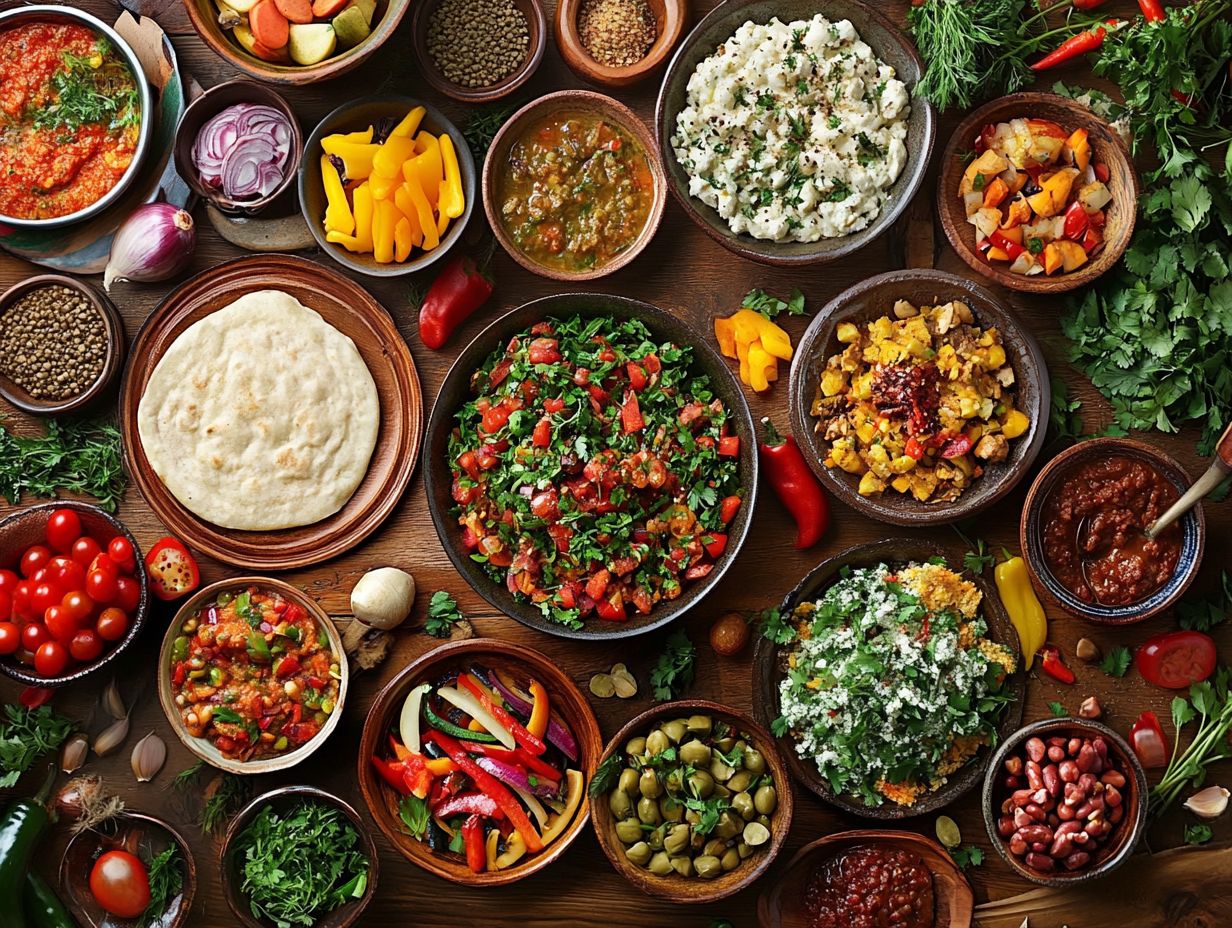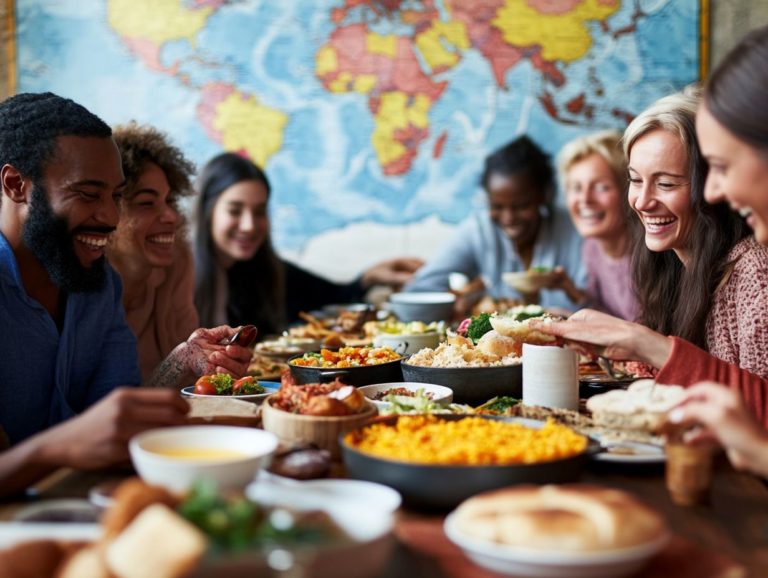What to Know About Local Cuisine?
Local cuisine transcends mere sustenance; it unfolds as a vibrant tapestry interwoven with history, culture, and the distinct ingredients of its region.
Every dish you encounter tells a unique story, shaped by the land and its inhabitants. This exploration delves into the essence of local cuisine, illuminating its rich history, diverse interpretations, and captivating flavor profiles.
From must-try dishes to dining etiquette, you’ll uncover how to truly savor the authentic tastes of various cultures while gracefully navigating unfamiliar culinary landscapes.
Jump in and let your taste buds take an exciting journey through the flavors of local cuisine!
Contents
Key Takeaways:

- Local cuisine reflects the history and cultural influences of a region, making it a unique and meaningful dining experience.
- From ingredients to flavors, local cuisine offers a diverse range of tastes that showcase the region’s distinct culinary identity.
- When trying local cuisine, it’s important to observe proper etiquette and be open-minded to new dishes for an authentic and enjoyable experience.
What is Local Cuisine?
Local cuisine encompasses the cooking traditions, practices, and dishes unique to your region. It often reflects the rich tapestry of local culture, agriculture, and food customs.
It’s characterized by a commitment to fresh produce sourced from local farms or farmers’ markets, emphasizing seasonal ingredients and regional specialties. This approach elevates your culinary experience and supports the local economy.
By embracing these unique flavors and cooking techniques that define your bioregion, you cultivate a deeper connection to the culture surrounding your food.
The essence of local cuisine links communities to their heritage through traditional recipes handed down through generations. Sourcing fresh ingredients directly from local producers ensures top-notch quality and strengthens the bonds between you and those who nurture the land.
Each local dish you savor has the power to evoke cherished memories, fostering a profound sense of belonging and nostalgia. However, the rise of mass-produced foods threatens this intimacy, often overshadowing the authentic tastes that characterize your region.
By choosing local food options, you actively support sustainable practices and contribute to preserving culinary traditions that are vital to your cultural identity.
History and Cultural Significance
The history of local cuisine is intricately woven into the cultural tapestry of food traditions that have been cherished and passed down through generations. These traditions are often tied to family farms and programs that connect local farmers with consumers.
They showcase the agricultural practices of a region and encapsulate the stories and memories that define a community’s identity. In an era of globalization and the encroachment of industrial food systems, it becomes essential to preserve these food customs and values, honoring the rich heritage they represent.
Evolution and Influences
The evolution of local cuisine is a fascinating journey shaped by a myriad of influences that define its identity, from historical trade routes to vibrant exchanges among diverse communities.
Each region boasts a unique culinary heritage, showcasing local dishes, ingredients, and cooking techniques molded by migrations, conflicts, and globalization, highlighting the dynamic essence of food culture.
Consider the Silk Road, which did more than facilitate the trade of goods; it introduced spices and cooking methods that turned traditional meals into delightful fusion creations. In coastal areas, the influx of immigrants brought seafood preparation techniques that have become staples think grilling and pickling each adapted to local palates.
Today, contemporary trends such as the shift towards organic and sustainable sourcing are reshaping how traditional recipes are approached, blending age-old practices with modern sensibilities. This harmonious evolution allows local cuisine to remain relevant while honoring its rich history, ensuring that the culinary landscape evolves yet stays true to its roots.
Regional Variations
Regional variations in local cuisine reveal the amazing tapestry of flavors, ingredients, and culinary techniques that flourish across diverse bioregions. Each variation is a testament to the unique how food is grown and harvested, climate, and cultural influences that shape its identity.
Imagine wandering through the vibrant farmers markets of Asheville, North Carolina, where the freshness of seasonal produce is palpable. Savor the rich spices of Moroccan cuisine that dance on your palate.
These regional distinctions show the significance of seasonal food and the invaluable contributions of local food producers. Experience the culinary richness that each area has to offer!
Different Types of Local Cuisine

Different types of local cuisine offer a delightful array of culinary experiences. From cherished family recipes handed down through generations to innovative street food that captures the very essence of a region s culture and local specialties, each type beckons you to embark on a food journey.
Explore authentic restaurants and vibrant food markets that showcase seasonal ingredients and unique flavors. Street food, often bustling in night markets or at corner stalls, serves as your informal introduction to local tastes.
Vendors frequently source their ingredients from nearby farms, crafting dishes that resonate with community traditions and cherished memories. On the other hand, home-cooked meals embody the heart of a family’s heritage.
Here, recipes are more than just nourishment; they tell stories and maintain bonds that connect generations. Fine dining establishments take these flavors to the next level, showcasing artistry and seasonal products in an elegant setting.
Each meal becomes a celebration of local culture and its evolving identity. Together, these diverse culinary experiences weave a rich tapestry of flavors that beautifully encapsulates the spirit and values of the community, inviting you to savor every moment.
Ingredients and Flavors
The ingredients and flavors that shape local cuisine are intricately tied to the availability of fresh produce, distinctive spices, and traditional cooking methods. These elements showcase the rich culinary heritage of the region.
By grasping these foundational ingredients and flavor profiles, you can truly appreciate the depth and diversity of local dishes. They resonate with seasonal variations and carry significant cultural meanings.
Common Ingredients and Flavor Profiles
Common ingredients in local cuisine often feature fresh vegetables, meats, and spices native to the region. Each adds its unique flair to local dishes.
These ingredients showcase the agricultural wealth of the area and invite you on a food journey as you explore the tastes and aromas that embody your culture. For instance, consider the role of tomatoes, essential in Mediterranean dishes like ratatouille.
They meld beautifully with herbs such as basil and thyme, creating a symphony of flavors. Similarly, spices like cumin and coriander are cornerstones in Middle Eastern cooking, forming the backbone of beloved dishes like falafel and shawarma.
They enrich not just the palate but also the cultural stories intertwined with communal meals. By understanding these ingredients, you connect to your history and the shared experiences that are vital to culinary traditions.
Each bite narrates the story of the land, the climate, and the people who cultivate and prepare these timeless recipes. Don t miss out on the chance to taste these amazing flavors!
Popular Dishes
Popular dishes within local cuisine offer you a window into the essence of a region’s culinary journey. They highlight must-try dishes that embody local specialties and cherished cooking traditions.
Whether you’re indulging in meals at authentic restaurants or wandering through vibrant street food stalls, these culinary experiences are critical for any food enthusiast. They are eager to grasp the cultural significance of a region’s cuisine.
Try these dishes today! Explore your local markets to experience the seasonal flavors!
Must-Try Dishes in Different Regions
Must-try dishes vary significantly across different regions, each offering a unique food journey that highlights local specialties, food customs, and the vibrant flavors of the area. Whether you’re indulging in Asheville’s celebrated farm-to-table creations or exploring the fragrant spices of Indian cuisine, these dishes narrate a rich story of cultural heritage and culinary artistry.
Take, for example, the experience of enjoying a traditional paella in Valencia. This dish introduces you to saffron-infused rice (rice flavored with saffron, a precious spice that gives dishes a rich color and taste) and an array of fresh seafood, immersing you in the region’s lively gatherings and celebrations. Similarly, when you savor the delectable street food in Bangkok think pad thai and mango sticky rice you tap into the bustling energy of Thai culture and its deep culinary traditions.
Every bite captures the essence of its origins, allowing you to connect with local customs and flavors in unforgettable ways. Embracing the chance to savor these dishes authentically transforms your travel experience, creating lasting memories that are as much about the people and places as they are about the food itself.
Etiquette and Customs

Grasping the nuances of proper etiquette and customs when indulging in local cuisine is paramount for truly appreciating the cultural significance woven into food traditions across various regions. These dining practices elevate your overall experience and mirror the values and social norms of the communities you encounter on your culinary journey.
Proper Etiquette When Dining on Local Cuisine
Understanding proper etiquette is essential, as it varies by region and often includes grasping dining customs. This knowledge encompasses how to present yourself at the table and how to genuinely appreciate the food served. By embracing these customs, you elevate your food journey and deepen your appreciation for the cultural significance woven into food traditions.
For example, in certain Asian cultures, quietly savoring each bite is considered a compliment to the chef. In Mediterranean countries, engaging in lively conversation and sharing dishes is encouraged as a core aspect of the meal. Participating in these practices demonstrates respect for the local culture and transforms a simple meal into a rich experience steeped in tradition.
Observing local customs such as the way bread is broken or how courses are served highlights the communal aspect of dining and allows you to forge meaningful connections with fellow diners. Respecting these traditions can significantly enhance the joy of discovering and enjoying diverse flavors, turning every meal into a delightful exploration.
Tips for Trying Local Cuisine
Diving into local cuisine is an exciting journey that you won t want to miss! Equipping yourself with tips on navigating unfamiliar dishes can elevate your experience, allowing for a deeper appreciation of food customs.
Whether you find yourself wandering through bustling food markets or savoring meals at authentic restaurants, understanding local recommendations will empower you to make informed and delightful food choices.
Navigating new and unfamiliar dishes can be an exhilarating part of your culinary journey. It calls for an open mind and a genuine willingness to embrace the unique food customs of each region. By seeking recommendations from locals and diving into the cultural significance of specific dishes, you can elevate your dining experience and cultivate meaningful connections with the local food culture.
Instead of simply ordering from the menu, engage in conversations with your server or fellow diners. They may offer valuable insights into the ingredients and preparation methods that define each dish. This curiosity not only deepens your understanding but also heightens your appreciation for the artistry woven into culinary traditions.
By embracing the nuances of each plate, you ll discover flavors that might have remained hidden otherwise. Ultimately, every bite carries a story, and by tuning into these narratives, you can transform a meal into an immersive cultural experience.
Frequently Asked Questions
Have more questions? Feel free to ask!
What to Know About Local Cuisine?

Local cuisine refers to the food and dishes unique to a region or culture.
It reflects local ingredients, cooking methods, and traditions.
What makes local cuisine special?
Local cuisine offers a taste of a place’s culture and history.
You can enjoy unique flavors not found elsewhere.
What should I expect when trying local cuisine?
Expect new and unfamiliar ingredients and flavors.
You might be thrilled to discover dishes prepared in surprising ways or with cultural importance.
How can I find the best local cuisine?
Ask locals for recommendations or research ahead of time.
Street food, markets, and local restaurants are great places to discover hidden gems.
What if I have dietary restrictions or allergies?
Inform the restaurant or food vendor about your dietary needs.
They may suggest safe alternatives or accommodate your restrictions.
Is it important to try local cuisine when traveling?
Trying local cuisine is essential for experiencing a place’s culture.
It also supports the local economy and promotes sustainability through locally sourced ingredients.






